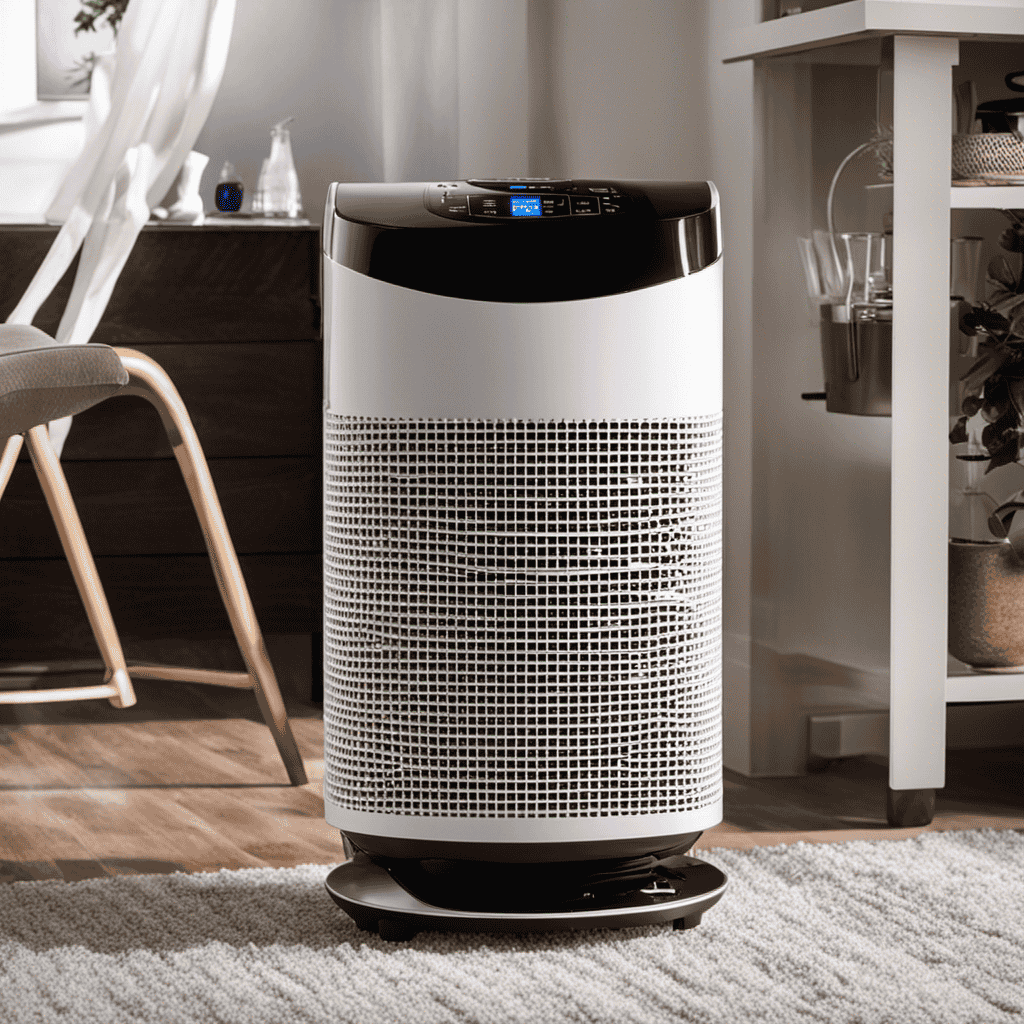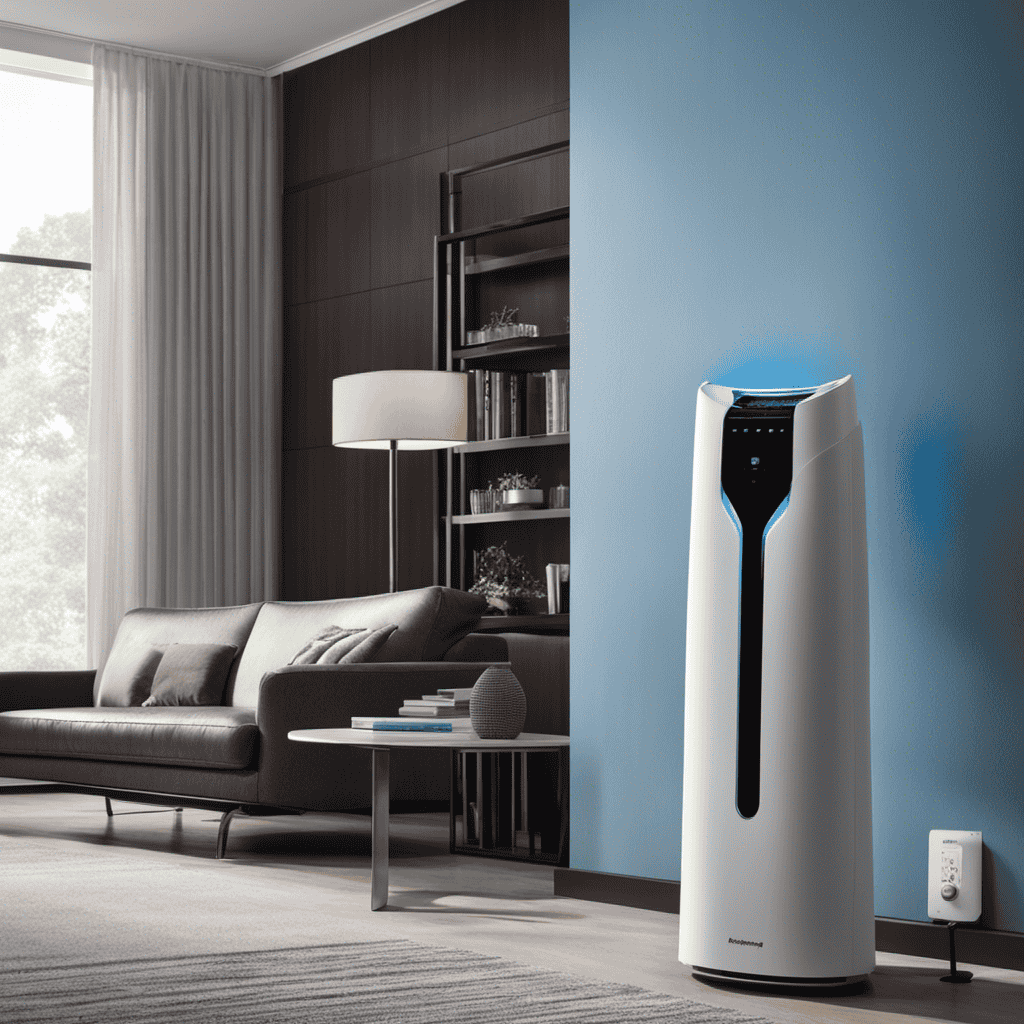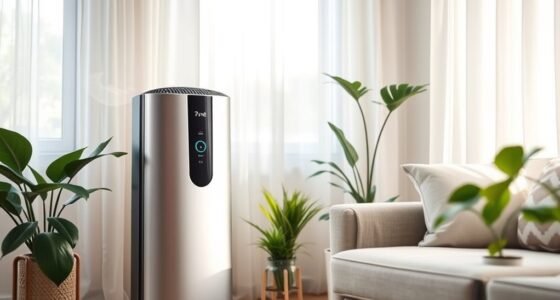As I sit in my living room, I can’t help but notice the dusty air that fills the space. It’s like trying to breathe through a clogged filter.
That’s when I realize I need a home air purifier. But with so many options available, how do I choose the right one?
In this article, I will guide you through the factors to consider, different types of air purifiers, and the essential features to look for.
Let’s clear the air and breathe easy again.
Key Takeaways
- Consider factors such as room size, specific air quality needs, cost considerations, and maintenance requirements when choosing a home air purifier.
- There are different types of air purifiers available, including whole house systems and portable units, with options for installation and coverage area.
- Understand the various air purification technologies, such as HEPA filters, activated carbon filters, UV-C light, and ionizers, as well as the importance of regular maintenance.
- Evaluate air purifier performance using key indicators like CADR, ACH, filtering efficiency, and noise level, and look for essential features like air purification technologies, filter type and replacement frequency, coverage area, and additional features.
Factors to Consider
When choosing a home air purifier, you’ll want to consider factors such as the size of the room and your specific air quality needs. Cost considerations and maintenance requirements are also important factors to take into account.
The cost of an air purifier can vary greatly depending on its features and capabilities. It’s essential to set a budget and find a purifier that fits within that range. Additionally, you should consider the long-term maintenance requirements of the purifier. Some models may require frequent filter replacements or professional servicing, which can add to the overall cost.
By carefully considering these cost considerations and maintenance requirements, you can choose an air purifier that not only fits your budget but also meets your air quality needs.
Now, let’s move on to discussing the different types of air purifiers.
Types of Air Purifiers
There are various types of air purifiers available for you to consider. When it comes to choosing the right air purifier for your home, you have two main options: whole house systems and portable units. Whole house air purifiers are designed to clean the air throughout your entire home. They are typically installed in your HVAC system and can effectively remove pollutants from every room. On the other hand, portable air purifiers are more flexible and can be moved from room to room as needed. They are great for targeting specific areas or for those who live in smaller spaces. Here is a comparison table to help you understand the differences between whole house and portable air purifiers:
| Whole House Air Purifiers | Portable Air Purifiers | |
|---|---|---|
| Installation | Integrated with HVAC system | Standalone units |
| Coverage Area | Entire home | Specific rooms |
| Cost | Higher upfront cost | Lower upfront cost |
| Maintenance | Requires professional maintenance | Easy to clean and maintain |
Consider your specific needs and budget when choosing between whole house and portable air purifiers.
Understanding Air Purification Technologies
Understanding the different air purification technologies can help you make an informed decision about which option is best for you. When it comes to air purifier maintenance and the benefits of clean air, it’s important to consider the specific technologies used in each device.
There are several common air purification technologies, including HEPA filters, activated carbon filters, UV-C light, and ionizers. HEPA filters are highly effective in removing particles as small as 0.3 microns, while activated carbon filters are great at eliminating odors and harmful gases. UV-C light can kill bacteria and viruses, while ionizers release negatively charged ions to attract and remove pollutants from the air.
Regular maintenance, such as cleaning or replacing filters, is crucial to ensure optimal performance and clean air in your home. By understanding these technologies, you can choose the best air purifier for your specific needs and enjoy the benefits of clean air.
Evaluating Air Purifier Performance
When it comes to evaluating air purifier performance, there are several key points to consider.
Firstly, it is important to examine the key performance indicators (KPIs) of the air purifier, such as its clean air delivery rate (CADR) and its coverage area.
Secondly, comparing the filtering efficiency of different air purifiers is crucial in determining their effectiveness in removing pollutants from the air.
Lastly, assessing the noise level of the air purifier is essential as it can impact the overall user experience and comfort.
Key Performance Indicators
To accurately assess the efficiency of a home air purifier, you should consider key performance indicators such as Clean Air Delivery Rate (CADR) and Air Changes per Hour (ACH). CADR measures the speed at which the air purifier can remove specific types of pollutants from the air, such as dust, pollen, and smoke. A higher CADR indicates better performance in improving air quality. ACH, on the other hand, measures how many times the air purifier can clean the entire volume of air in a room in one hour. The higher the ACH, the more effectively the air purifier can remove pollutants and maintain clean air.
Here is a table summarizing the importance of CADR and ACH in evaluating air purifier performance:
| Key Performance Indicators | Importance |
|---|---|
| CADR | Measures the speed at which pollutants are removed from the air. Higher CADR indicates better performance. |
| ACH | Measures how many times the air purifier can clean the entire volume of air in a room in one hour. Higher ACH indicates more effective air cleaning. |
Considering these indicators will help you make an informed decision when choosing a home air purifier that meets your air quality needs and maintenance requirements.
Filtering Efficiency Comparison
If you’re comparing filtering efficiency, take note of the Clean Air Delivery Rate (CADR) and Air Changes per Hour (ACH) to determine the most effective option.
When it comes to air purifiers, maintaining clean air is essential for our health and well-being. Regular air purifier maintenance ensures that the filtering efficiency remains high, allowing us to reap the benefits of clean air.
The CADR measures how quickly an air purifier can filter the air in a room, while the ACH indicates how many times the air in a room is completely filtered per hour. By comparing these two indicators, we can choose an air purifier that effectively removes pollutants from our indoor environment.
This is important because clean air promotes better respiratory health, reduces allergies, and creates a more comfortable living space.
Noise Level Assessment
The noise level of the air purifiers greatly impacts the comfort level of our living space. When choosing an air purifier, it’s important to consider its quiet operation and the decibel level measurement. Noisy air purifiers can be disruptive and cause discomfort, especially during nighttime or when trying to concentrate. To help you make an informed decision, here is a comparison table of the noise levels of different air purifiers:
| Air Purifier Model | Noise Level (dB) | Quiet Operation |
|---|---|---|
| Model A | 30 dB | Yes |
| Model B | 40 dB | No |
| Model C | 35 dB | Yes |
As you can see, Model A and Model C offer quieter operation with noise levels at or below 35 dB. These models are more suitable for maintaining a peaceful and comfortable living space.
Essential Features to Look for
When it comes to choosing an air purifier for your home, two key features to consider are the air purification technologies used and the noise level produced.
The air purification technologies determine the effectiveness of the purifier in removing pollutants from the air, while the noise level considerations ensure that the purifier doesn’t create a disturbance in your living space.
Researching and understanding these features will help you make an informed decision and select an air purifier that meets your specific needs and preferences.
Air Purification Technologies
One of the most common air purification technologies is HEPA, which stands for high-efficiency particulate air. HEPA filters are designed to capture particles as small as 0.3 micrometers, making them highly effective at removing common air pollutants such as dust, pollen, pet dander, and mold spores. Other air purification technologies include activated carbon filters, which are effective at removing odors and VOCs, and UV-C light technology, which helps to kill bacteria and viruses.
To give you a visual representation of the different air purification technologies, here is a table showcasing their features:
| Air Purification Technology | Key Features |
|---|---|
| HEPA | Captures particles as small as 0.3 micrometers |
| Activated Carbon | Removes odors and volatile organic compounds (VOCs) |
| UV-C Light | Kills bacteria and viruses |
Using air purifiers that incorporate these technologies can provide numerous benefits. They can help improve indoor air quality by removing harmful pollutants, reduce allergy symptoms, and create a healthier living environment. Additionally, air purifiers can help eliminate unpleasant odors, making the air in your home feel fresher and cleaner.
Noise Level Considerations
Consider the noise level of air purifiers before making a purchasing decision. When it comes to home air purifiers, silent operation is a crucial factor to consider.
No one wants an air purifier that disturbs their peace and quiet. That’s why it’s essential to look for models that are specifically designed for silent operation. These air purifiers are equipped with soundproof designs that minimize noise levels, allowing you to enjoy clean air without any distractions.
Many brands now offer air purifiers with advanced soundproofing technology, ensuring that the purifier operates quietly in the background. Before buying an air purifier, make sure to check the noise level specifications and customer reviews, as they can provide valuable insights into the product’s performance.
Budget Considerations
If you’re on a tight budget, it’s important to prioritize the features that are most essential to you when choosing a home air purifier. Conducting a cost analysis can help you identify affordable options that meet your needs.
Here are some factors to consider:
-
Filter replacement cost: Look for air purifiers with low-cost replacement filters, as these can significantly impact long-term expenses.
-
Energy consumption: Opt for energy-efficient models to minimize electricity costs.
-
Maintenance and cleaning requirements: Consider air purifiers that are easy to clean and maintain, as this can save you time and money.
Frequently Asked Questions
Can an Air Purifier Remove All Types of Contaminants From the Air?
An air purifier can remove various types of contaminants from the air, but its effectiveness depends on the specific model and its filtration system. Regular maintenance, such as cleaning or replacing filters, is crucial to ensure optimal performance.
Are Air Purifiers Noisy When They Are in Operation?
Yes, air purifiers can be noisy when in operation but it depends on the model. Regular air purifier maintenance can help reduce noise levels. Despite the noise, the benefits of using an air purifier outweigh the inconvenience.
Can an Air Purifier Help With Allergies Caused by Pet Dander?
An air purifier can help with allergies caused by pet dander by filtering out allergens from the air. Regular maintenance, such as cleaning or replacing filters, is important to ensure the effectiveness and long-term benefits of using an air purifier.
How Often Should the Filters in an Air Purifier Be Replaced?
I recently discovered my air purifier’s filters were clogged, affecting its performance. To prolong the lifespan of air purifier filters, regular maintenance and cleaning are essential. Determining when to replace filters depends on usage and the manufacturer’s recommendations.
Are There Any Health Risks Associated With Using an Air Purifier for Long Periods of Time?
There may be health risks associated with using an air purifier for long periods of time. It is important to consider the potential effects on air quality and consult with a healthcare professional for guidance.
Conclusion
After thoroughly researching and analyzing the factors to consider when choosing a home air purifier, it is clear that making an informed decision is crucial.
Understanding the different types of air purifiers and their technologies is essential to ensure optimal performance.
Evaluating the purifier’s performance and looking for essential features that meet your specific needs is also important.
Lastly, budget considerations play a significant role in narrowing down the options.
So, don’t procrastinate any longer – take the leap and invest in a home air purifier to improve your indoor air quality and breathe in fresh, clean air.










